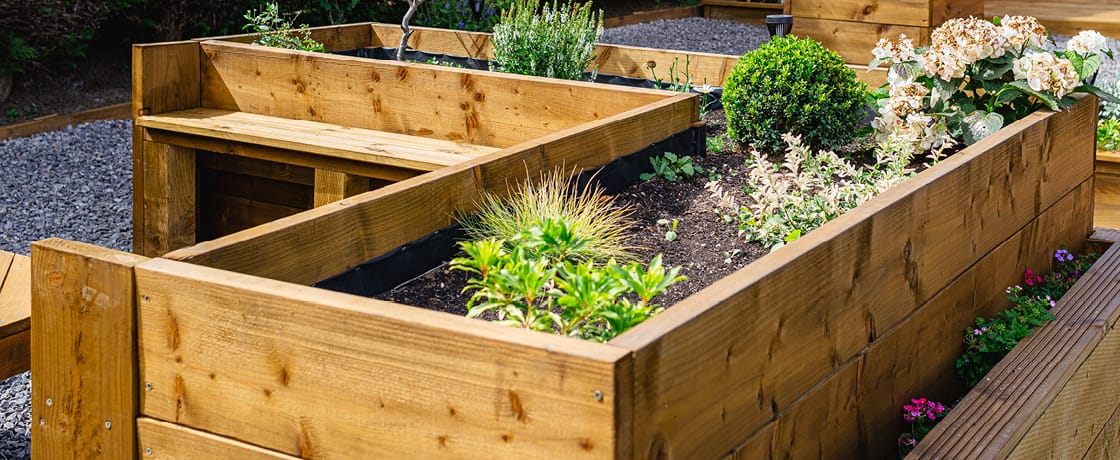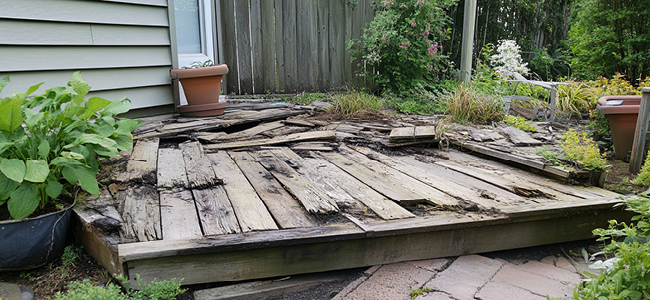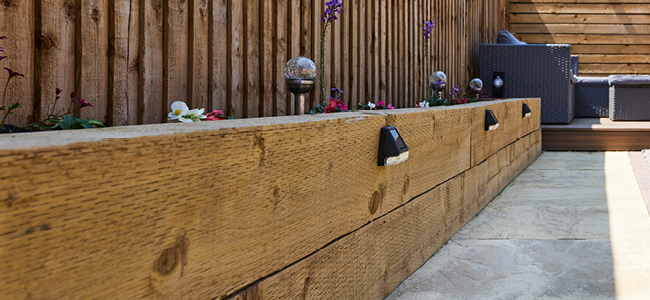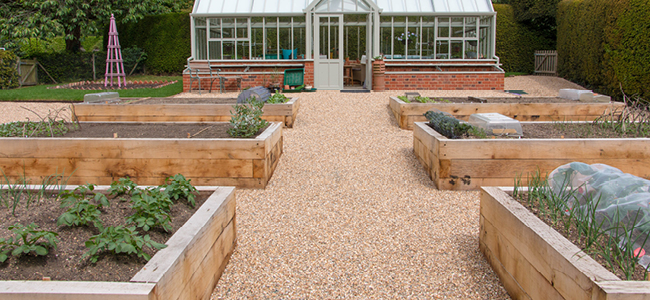
How to Prevent Sleepers from Rotting: A Complete Guide for Your Garden or Outdoor Projects
Published on May 30, 2025
Posted in How To
by MKM
6 min read
Sleepers are a solid choice for any outdoor space – whether you're building raised beds, edging a path, or putting up a retaining wall. But with the UK's wet weather, rot is a common issue. Here’s how to stop it before it starts.
Why Do Sleepers Rot? Rot is one of the most common problems affecting timber sleepers, especially when they're used outdoors in landscaping, garden edging, or retaining walls. It occurs when the wood remains damp for long periods, creating the perfect environment for fungi and bacteria to thrive. These organisms feed on the natural components of the wood — primarily cellulose and lignin — gradually breaking it down and weakening the structure.

Main causes of sleeper rot:
Constant Moisture Exposure: When sleepers are in regular contact with soil, mulch, or standing water, they struggle to dry out properly. Timber needs time and airflow to shed moisture, but being embedded in the ground or placed in poorly drained areas means the wood stays damp, allowing rot to set in. Waterlogged soil and shaded spots with little airflow make this problem worse.
Timber Type: Not all wood is created equal. Softwoods such as pine or spruce, while affordable and easy to work with, are far more vulnerable to rot if they haven’t been pressure treated. In contrast, pressure-treated timber is infused with preservatives that protect against fungal decay and insect attack. Some hardwoods, like oak or iroko, have natural oils and density that make them far more durable in outdoor environments — though they come at a higher cost.
Lack of Treatment: Timber that hasn’t been treated, or that has lost its protective treatment over time, is at significant risk of rotting. Untreated sleepers exposed to rain, damp soil, or frost will begin to break down much faster than treated alternatives. This is why regular maintenance — such as reapplying a suitable preservative — is crucial if you want your sleepers to last.
Other contributing factors include:
- Poor Drainage: Sleepers sitting in puddles or soggy ground are essentially soaking in rot-promoting moisture.
- Inadequate Ventilation: Airflow is key to drying wood. If sleepers are tightly packed or buried, they stay damp longer.
- Build-up of Organic Matter: Leaves, mulch, or compost left against sleepers can trap moisture and feed decay fungi.
How to Spot Rot Early Catching rot early can save you money and effort. Look for these signs:
Spongy, Soft Patches: Press on the wood – if it gives way easily or feels unusually soft, it could be rotting.
Dark or Discoloured Areas: Black, grey, or dark brown stains often signal the start of decay. These patches may spread over time.
Fungal Growth: White, black, or brown fungal growth on the surface indicates that the timber is staying damp long enough for fungi to thrive.
Cracks or Splitting: As rot progresses, timber may crack or split. These openings allow more moisture in, speeding up the deterioration.
Make it a habit to inspect your sleepers regularly, especially in shaded areas or those prone to retaining moisture. Early detection means you can intervene before serious damage occurs.
Can You Repair Rotten Sleepers? In some cases, yes — especially if the rot is caught early and confined to a small section.
- Cut Out the Rot: Use a saw or chisel to remove all visibly affected wood. Don’t leave any soft or crumbly timber behind, as this will continue to decay.
- Use a Wood Hardener: Apply a high-quality wood hardener to the surrounding area. This product penetrates and reinforces the remaining timber, helping to restore some structural integrity.
- Seal the Area: After treating the wood, apply a good-quality wood preservative to prevent further fungal growth. If possible, repaint or seal the entire sleeper for added protection.
If the damage is extensive — covering more than half of the sleeper or compromising its strength — replacement is usually the more reliable and cost-effective option.
How to Prevent Rot (DIY & Trade Solutions)
DIY Methods:
- Apply Preservatives: Use modern wood treatments, creosote substitutes, or bitumen-based paints to coat your sleepers. These create a barrier that repels water and deters insects and fungi.
- Reduce Soil Contact: Where sleepers must be placed in or near soil, line them with heavy-duty plastic sheeting. This moisture barrier helps keep damp earth away from the timber.
- Improve Drainage: Before laying sleepers, spread a layer of gravel or coarse sand underneath. This prevents standing water from pooling directly under the wood.

Professional Solutions:
- Use Protective Tapes Between Sleepers: Products like Walther Strong sleeper tape are waterproof, self-sealing tapes designed to go between sleepers where they stack or touch. They form a protective barrier that keeps moisture from getting trapped in joints and layered areas, where rot is more likely to develop. These tapes are especially useful in retaining walls or tiered planters, significantly increasing the timber's lifespan.
- Use Pressure-Treated Sleepers: These are treated with preservatives under high pressure, which forces protection deep into the wood. They offer excellent resistance to decay, insects, and moisture.
- Choose Hardwoods: If budget allows, go for naturally rot-resistant hardwoods like oak or iroko. These woods have dense structures and natural oils that offer long-term durability with minimal maintenance.
Best Preservers for Garden Sleepers When selecting a wood preserver, choose one suited for external timber use:
- Ronseal Total Wood Preserver: A versatile treatment that offers protection against moisture, woodworm, and rot.
- Cuprinol Timbercare: Ideal for adding colour and a layer of protection. It comes in various shades and is easy to apply with a brush or sprayer.
Apply preservatives in dry conditions. Multiple coats are recommended for maximum penetration and protection. Be sure to treat all sides, including cut ends, as these are particularly vulnerable to moisture.
Building Raised Beds? Avoid Rot with These Tips:
- Line the Inside: Adding a waterproof membrane such as pond liner or damp-proof membrane prevents wet soil from coming into direct contact with the timber.
- Add Drainage: Ensure water can flow out easily. Drill small drainage holes in the lining or base if needed.
- Keep Sleepers Off the Ground: Elevate sleepers slightly by placing them on gravel beds or concrete pads. This allows water to drain away and air to circulate underneath.
- Seal Every Side: Don’t just treat the visible parts. Apply preservative to all surfaces, including the bottom, ends, and any cuts or drill holes.

Which Sleepers Last Longest?
- Reclaimed Railway Sleepers: These are typically hardwoods and were often treated with old-fashioned (and now restricted) preservatives like creosote. They’re extremely durable but may leach chemicals, making them unsuitable for food-growing areas.
- Softwood Sleepers: Affordable and widely available. However, they require pressure treatment and regular maintenance to ensure longevity.
- Hardwood Sleepers: The most durable option. Woods like oak or tropical hardwoods are naturally rot-resistant, but they do come with a higher upfront cost. They’re ideal for long-term projects where minimal upkeep is preferred.
Do Reclaimed Sleepers Rot?
Yes — eventually. While reclaimed sleepers are often dense and well-aged, they are not immune to decay. Over time, especially if exposed to new conditions or if their old treatments wear off, they can begin to rot. Inspect them closely before use and consider re-treating them to ensure continued protection.
Tips to Make Sleepers Last Longer
- Reapply preservatives annually, particularly before winter.
- Divert water away using guttering or landscaping.
- Regularly remove leaves, soil, or mulch piled up against the wood.
- Check sleepers for signs of wear and address issues early.
When to Replace Sleepers Replacement may be necessary when:
- The sleeper is no longer structurally sound (crumbles or moves under weight).
- More than half the wood is affected by rot.
- Repairs are more expensive or labour-intensive than installing a new sleeper.
Keeping sleepers in top shape is all about choosing the right materials, treating them properly, and doing a bit of maintenance now and then. A little effort gives you years of reliable use.
Need help choosing sleepers or timber treatments? Check out our online range here or visit your local branch to chat with one of our landscaping specialists.

Sources:
» https://www.gardeningetc.com/